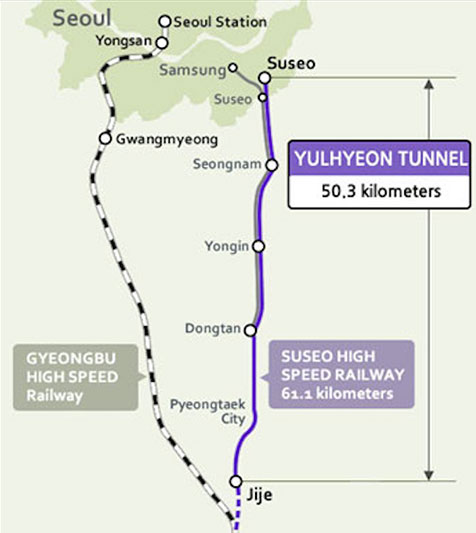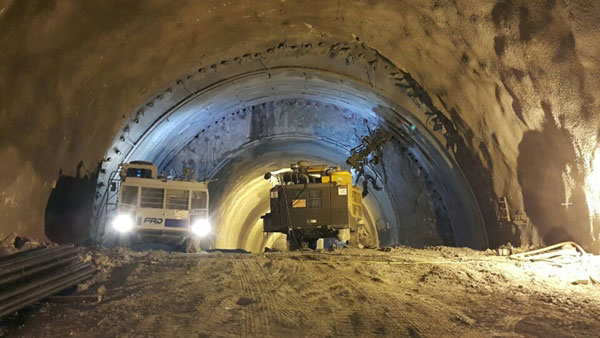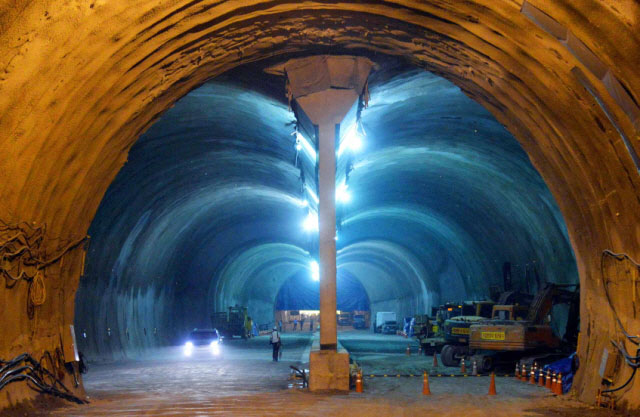It is the third longest railway tunnel in the world - after the 57km Gotthard Base Tunnel in Switzerland and the 54km Seikan Tunnel in Japan - and it took three years and five months in Korea to reach the final breakthrough of the 50.3km long Yulhyeon Tunnel on the Suseo High Speed Railway in Yongin-si City, south of the capital city Seoul in Gyeogngi-do Province.
At a grand ceremony on 24 June 2015, Government officials and senior managers of the Korea Rail Network Authority celebrated final excavation and completion of initial support of the full 50.3km length of the single tube, double track tunnel. Work now continues to complete the final permanent concrete and systems installations towards a planned opening of train services in July 2017.
The long Yulhyeon Tunnel accounts for 82% of the entire length of the 61.1km Suseo High Speed Railway line to connect Suseo Station in Seoul and Pyeongtaek in Gyeonggi-do Province, via Dongtan Station. The new link to connect Dongtan New City and the Godeok International New Town District in Pyeongtaek, is a vital element in the Korean Government’s so-called ‘half-day life zone’ plan for the country, meaning that people can reach any point in South Korea from any other point in the country in less than half a day.
Excavation of the double track tunnel, with a 107m2 internal area after installation of the final concrete lining began in January 2012 using mostly drill+blast and NATM excavation and immediate support methods. Civil excavation works within the total project construction cost of approximately US$3 billion, were let as 12 construction lots to 10 prime South Korean tunnel contractors (Table 1).
| Table 1. Yulhyeon Tunnel excavation lots and section contractors | ||||
| Tunnel length (m) | ||||
| Lot | Contractor | Mined | Cut and cover |
New Station |
| 1-1 | Kolon Global | - | 693 | Suseo (KTX) |
| 1-2 | Keangnam Enterprises | 5,000 | 387 | |
| 2 | Doosan Engineering & Construction | 8,200 | - | Sungnam |
| 3-1 | Daewoo Engineering & Construction | 5,685 | - | |
| 3-2 | GS Engineering & Construction | 5,911 | - | Yongin |
| 4 | Hyundai Development Co | 5,101 | - | |
| 5 | Samsung C&T | 1,993 | - | Dongtan (KTX) |
| 6-1 | Ssangyong Engineering & Construction | 5,670 | - | |
| 6-2 | Hyundai Development Co | 8,590 | - | |
| 7 | POSCO Engineering & Construction | 3,420 | 380 | Jije (KTX) |
| 8 | SK Engineering & Construction | 772 | 660 | |
| Total | 50,342 | 2,120 | 5 | |
Excavation was completed in a total 21 headings advanced from access adits at every 2-3km of the main tunnel length, each adit provided at least two tunnel headings. Ventilation shafts are located at about 3km intervals along the main tunnel alignment. The rail alignment runs mostly beneath a low mountainous area and there are no cities or urban areas above. In zones of soft ground, a pilot tunnel with a center pillar and double arch NATM excavation to full cross section was utilized to control ground deformations.
The total excavation period, including access adits and ventilation shafts, was a swift three years and five months from January 2012 to June 2015. A Korean tunnelling engineer who worked on similar tunnelling projects in Korea, and who is now working on a tunnelling project in the United States, told TunnelTalk: “The planning, design and construction for the NATM excavation and initial support processes were optimized and organized according to the detailed geological investigation programs and by the highly experienced tunnel design and construction engineers, so that there was no major problems during excavation progress at all.”
One of the most challenging sections on the project, he explained, was Contract No 4 located under the Shingal fault zone and Giheung reservoir. “After careful excavation, the section holed through successfully in March 2013.”
Final concrete lining and finishing works have been progressing in a rolling programme as sections of excavation and primary support have been made available.
Once completed and in service, the journey time through the Yulhyeon Tunnel will be about 14 minutes at an average 240km/hour.
References
- History in the making at St Gotthard – TunnelTalk, October 2010
- Maximising the final concrete lining operation on the St Gotthard TBM tunnels – TunnelTalk, December 2004
|
|
|
|
|
Add your comment
- Thank you for taking the time to share your thoughts and comments. You share in the wider tunnelling community, so please keep your comments smart and civil. Don't attack other readers personally, and keep your language professional.





